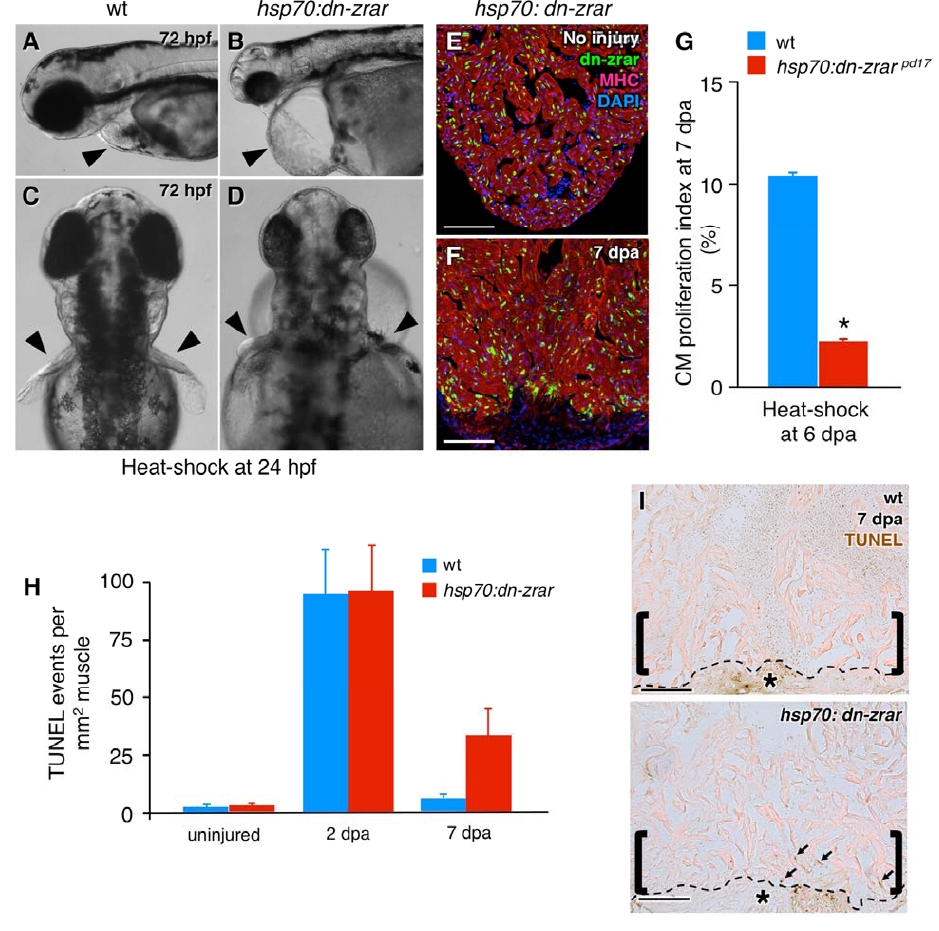Fig. s3
Effects of dn-zrar Induction during Embryogenesis and Regeneration
(A-D) A single heat-shock at 37°C for 30 minutes was delivered to hsp70:dn-zrar or wild-type (wt) embryos at 24 hours post-fertilization (hpf) as described previously (Lee et al., 2005). At 72 hpf, cardiac edema (B, arrowheads) and pectoral fin reductions (D, arrowheads) were observed in hsp70:dn-zrar embryos, but not in wt (A, C, arrowheads). Cardiac edema was observed in all embryos with pectoral fin defects. (E, F) Cardiomyocyte expression and nuclear localization of the dn-zrar inhibitory product (green) in sections of uninjured (E) and regenerating (F) ventricles. Most or all cardiomyocytes show strong nuclear dn-zrar expression one day after a heat-shock. Scale bars = 100 μm in (E, F, H, and I).
(G) A second line of hsp70:dn-zrar was analyzed at 7 dpa for cardiomyocyte (CM) proliferation, after a single heat-shock at 6 dpa. wt, clutchmate control. Data are mean ± SEM of 4 animals analyzed (2364 wt and 3038 transgenic cardiomyocytes analyzed). *p < 3 x 10-8, Student′s t-test.
(H, I) Apoptosis was examined by TUNEL assay and quantified in wt and hsp70:dn-zrar ventricles one day after a single heat-shock. TUNEL signals were quantified at the apex for uninjured ventricles, and at the apical injury site at 2 dpa and 7 dpa. TUNELpositive CMs were rare in uninjured animals, and appeared at similar frequencies at 2 dpa in wt and hsp70:dn-zrar injuries. Unlike 7 dpa wt ventricles, some 7 dpa transgenic ventricles displayed several TUNEL-positive cells within the myocardium (arrows in bracketed area of (I)), but overall there were no significant differences at the tested timepoints. Apoptotic cells were detected in the clot (asterisk) in both wt and transgenic ventricles. The dotted lines indicate approximate borders of the clot. Data are mean ± SEM of 3-9 animals analyzed.
Reprinted from Developmental Cell, 20(3), Kikuchi, K., Holdway, J.E., Major, R.J., Blum, N., Dahn, R.D., Begemann, G., and Poss, K.D., Retinoic Acid production by endocardium and epicardium is an injury response essential for zebrafish heart regeneration, 397-404, Copyright (2011) with permission from Elsevier. Full text @ Dev. Cell

